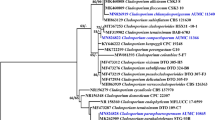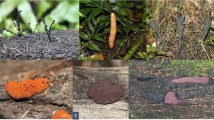Abstract
MOST basidiomycete cultures, whether isolated from decay in wood, from portions of basidiocarps, or from spore casts, are dicaryotic. Monocaryotic mycelia needed for special investigations, such as interfertility testing, are usually obtained from single basidiospores. Monocaryons may, however, arise directly from the dicaryotic mycelium of some species during culture on artificial media, and in most species they can be produced from dicaryons by microsurgery1,2, by high-speed blending3,4, or by the action of cholic acid derivatives5.
This is a preview of subscription content, access via your institution
Access options
Subscribe to this journal
Receive 51 print issues and online access
$199.00 per year
only $3.90 per issue
Buy this article
- Purchase on Springer Link
- Instant access to full article PDF
Prices may be subject to local taxes which are calculated during checkout
Similar content being viewed by others
References
Harder, R., Z. Bot., 19, 337 (1927).
Fries, N., and Aschan, Karin, Svensk. Bot. Tidskr., 46, 429 (1952).
Raper, J. R., Quart. Rev. Biol., 28, 233 (1953).
Papazian, H. P., Amer. J. Bot., 42, 394 (1955).
Miles, P. G., and Raper, J. R., Mycologia, 48, 484 (1956).
Author information
Authors and Affiliations
Rights and permissions
About this article
Cite this article
DA COSTA, E., KERRUISH, R. Production of Monocaryons in Basidiomycete Cultures by the Action of Toxic Chemicals. Nature 195, 726–727 (1962). https://doi.org/10.1038/195726b0
Issue Date:
DOI: https://doi.org/10.1038/195726b0
This article is cited by
-
Antifungal antibiotic of the basidiomyceteOudemansiella mucida
Folia Microbiologica (1977)
Comments
By submitting a comment you agree to abide by our Terms and Community Guidelines. If you find something abusive or that does not comply with our terms or guidelines please flag it as inappropriate.



